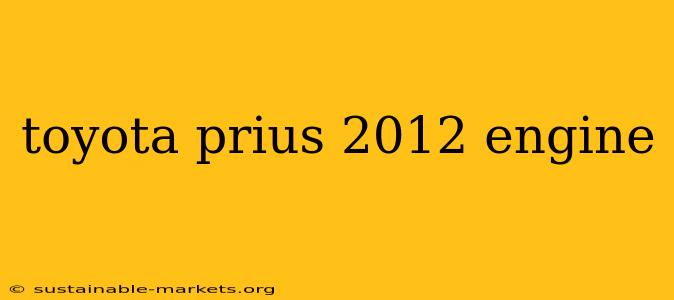The 2012 Toyota Prius, a landmark model in hybrid vehicle history, boasts a sophisticated powertrain that deserves a closer look. Understanding its engine—or, more accurately, its engine system—is key to appreciating its fuel efficiency and unique driving characteristics. This in-depth guide will explore the intricacies of the 2012 Prius's hybrid powertrain, covering its components, performance, and common maintenance considerations.
Understanding the Hybrid Synergy Drive
The heart of the 2012 Toyota Prius is its Hybrid Synergy Drive system. Unlike traditional gasoline-powered vehicles, the Prius doesn't rely solely on an internal combustion engine (ICE) for propulsion. Instead, it utilizes a sophisticated interplay between:
-
1.8L Atkinson-Cycle Gasoline Engine: This isn't your typical gasoline engine. The Atkinson cycle, designed for optimal fuel efficiency at lower RPMs, prioritizes maximizing the expansion stroke to improve fuel economy. It's not particularly powerful on its own, but it plays a crucial role in charging the hybrid battery and assisting the electric motor(s) during acceleration or higher-speed driving.
-
Electric Motor(s): The 2012 Prius employs two electric motors: a motor/generator (MG1) primarily responsible for charging the battery and assisting the gasoline engine, and a high-torque motor/generator (MG2) that directly powers the wheels. This dual-motor setup allows for seamless transitions between electric-only driving, engine-only driving, and combined power.
-
Nickel-Metal Hydride (NiMH) Battery: This battery pack stores energy generated by regenerative braking and the gasoline engine. This stored energy directly powers the electric motor(s) for acceleration and low-speed driving.
How the System Works Together
The beauty of the Hybrid Synergy Drive is its seamless integration of these components. The system constantly monitors driving conditions and adjusts the power distribution accordingly. For example:
- Low-speed driving: The Prius often runs solely on electric power, offering silent and emission-free operation.
- Moderate acceleration: The gasoline engine and electric motor work together, providing optimal power and efficiency.
- High-speed cruising: The gasoline engine primarily drives the wheels, with the electric motor assisting as needed.
- Regenerative braking: When braking, the electric motors act as generators, capturing kinetic energy and converting it into electricity to recharge the battery.
Performance and Fuel Economy
The combined output of the 2012 Prius's hybrid system is around 134 horsepower. While not exceptionally powerful, it provides ample acceleration for everyday driving. The real strength lies in its exceptional fuel economy, significantly higher than comparable gasoline-powered vehicles. The EPA estimated fuel economy figures are a testament to this efficiency.
Common Maintenance Considerations
Like any vehicle, the 2012 Prius requires regular maintenance. While the hybrid system is generally reliable, some specific considerations include:
- Hybrid Battery Health: The NiMH battery's lifespan depends on usage and care. Regular checkups by a qualified technician are recommended. Avoid frequent deep discharges to prolong its life.
- Coolant System: The hybrid system generates heat, so maintaining the proper coolant levels and condition is crucial.
- Regular Oil Changes: The gasoline engine still requires regular oil changes, following Toyota's recommended maintenance schedule.
Conclusion: A Pioneer in Hybrid Technology
The 2012 Toyota Prius engine system, with its innovative Hybrid Synergy Drive, represents a significant advancement in automotive technology. Its combination of fuel efficiency, smooth operation, and relatively low emissions cemented its place as a leading hybrid vehicle. Understanding its components and how they work together provides a deeper appreciation for this pioneering technology and its ongoing impact on the automotive industry. Proper maintenance is key to maximizing its lifespan and enjoying its many benefits.

